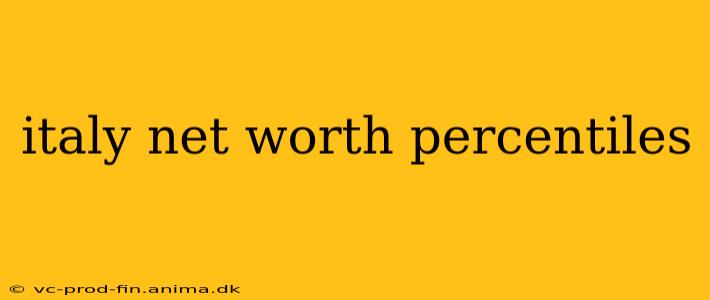Understanding the distribution of wealth in Italy is crucial for economists, policymakers, and anyone interested in the country's socioeconomic landscape. This analysis delves into the net worth percentiles in Italy, exploring the disparities and providing context for this complex topic. While precise, publicly available data on net worth percentiles for Italy can be limited and vary depending on the source and methodology, we can examine available information and draw meaningful conclusions.
What is Net Worth?
Before diving into Italian specifics, let's clarify the term "net worth." Net worth is the total value of a person's assets (e.g., property, investments, savings) minus their liabilities (e.g., debts, mortgages). It provides a snapshot of a person's overall financial health and is a key indicator of wealth distribution within a country.
Challenges in Determining Precise Net Worth Percentiles
Accurately calculating net worth percentiles for any country, including Italy, presents significant challenges. These include:
- Data Collection Difficulties: Obtaining comprehensive and reliable data on the assets and liabilities of the entire Italian population is a monumental task. Many assets, particularly privately held businesses and real estate, are not always publicly reported.
- Valuation Challenges: Accurately valuing assets like art, privately held companies, and real estate can be subjective and complex, leading to variations in estimates.
- Tax Avoidance and Evasion: Undeclared assets and tax avoidance complicate efforts to create a fully accurate picture of wealth distribution.
Available Data and Interpretations: A Look at Wealth Inequality
While precise percentile data might be unavailable publicly, research from organizations like Credit Suisse and other reputable sources periodically publish reports on global wealth distribution. These reports often include data aggregated for Italy, providing some insights. These reports typically reveal a considerable wealth gap in Italy, with a significant portion of the nation's wealth concentrated in the hands of a relatively small percentage of the population. This highlights the importance of ongoing research and policy discussions on wealth inequality.
What are the main factors contributing to wealth inequality in Italy?
Several factors contribute to wealth inequality in Italy. These include:
- Generational Wealth: Inherited wealth plays a significant role, with families accumulating assets over generations.
- Regional Disparities: Wealth is not evenly distributed across Italy's regions, with some areas significantly wealthier than others.
- Access to Education and Opportunities: Unequal access to quality education and economic opportunities exacerbates existing inequalities.
- Tax Policies: Tax policies and their impact on wealth accumulation are subjects of ongoing debate and influence wealth distribution.
Understanding the Implications of Wealth Distribution
The distribution of wealth has significant implications for:
- Social Mobility: A highly unequal distribution can limit social mobility, making it difficult for individuals to improve their economic standing.
- Economic Growth: Extreme wealth inequality can hinder economic growth by reducing consumer demand and investment.
- Social Stability: High levels of inequality can contribute to social unrest and political instability.
Frequently Asked Questions (Addressing potential "People Also Ask" queries)
What is the average net worth of an Italian citizen?
Providing an exact average net worth is difficult due to data limitations. However, reports suggest a wide range, with significant variations based on factors like age, region, and occupation.
How does Italy's wealth distribution compare to other European countries?
Italy's wealth distribution exhibits similar characteristics to other European countries, with varying degrees of inequality. However, direct comparisons require careful analysis of data methodologies and accounting for various socioeconomic factors.
What are the government's policies aimed at addressing wealth inequality in Italy?
The Italian government has implemented various policies aimed at reducing inequality. These may include tax reforms, social welfare programs, and initiatives to improve education and employment opportunities. The effectiveness of these policies remains a subject of ongoing evaluation and discussion.
What are the long-term consequences of high wealth inequality in Italy?
High wealth inequality can lead to long-term societal challenges. These might include reduced social cohesion, slower economic growth, and potential political instability.
Are there any resources where I can find more detailed information on Italian wealth statistics?
While specific percentile data may be limited, you can consult research publications from reputable organizations like the Bank of Italy, the OECD, Credit Suisse, and academic studies focusing on Italian wealth distribution for further information.
This overview provides a general understanding of net worth percentiles in Italy. It's essential to consult up-to-date research and reports for the most accurate and current data available on this complex subject. The ongoing research and debate surrounding wealth inequality highlight the significance of this topic for Italy's economic and social future.
